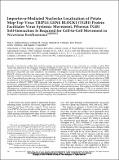Files in this item
Importin-α-mediated nucleolar localization of potato mop-top virus TRIPLE GENE BLOCK1 (TGB1) protein facilitates virus systemic movement, whereas TGB1 self-interaction is required for cell-to-cell movement in Nicotiana benthamiana
Item metadata
| dc.contributor.author | Lukhovitskaya, Nina I. | |
| dc.contributor.author | Cowan, Graham H. | |
| dc.contributor.author | Vetukuri, Ramesh R. | |
| dc.contributor.author | Tilsner, Jens | |
| dc.contributor.author | Torrance, Lesley | |
| dc.contributor.author | Savenkov, Eugene I. | |
| dc.date.accessioned | 2015-03-11T12:01:02Z | |
| dc.date.available | 2015-03-11T12:01:02Z | |
| dc.date.issued | 2015-03 | |
| dc.identifier | 173631819 | |
| dc.identifier | 5af1788e-88b5-4105-b58c-82369cacfe22 | |
| dc.identifier | 84923683587 | |
| dc.identifier | 000354413900012 | |
| dc.identifier.citation | Lukhovitskaya , N I , Cowan , G H , Vetukuri , R R , Tilsner , J , Torrance , L & Savenkov , E I 2015 , ' Importin-α-mediated nucleolar localization of potato mop-top virus TRIPLE GENE BLOCK1 (TGB1) protein facilitates virus systemic movement, whereas TGB1 self-interaction is required for cell-to-cell movement in Nicotiana benthamiana ' , Plant Physiology , vol. 167 , no. 3 , pp. 738-752 . https://doi.org/10.1104/pp.114.254938 | en |
| dc.identifier.issn | 0032-0889 | |
| dc.identifier.other | ORCID: /0000-0003-3873-0650/work/60630838 | |
| dc.identifier.uri | https://hdl.handle.net/10023/6204 | |
| dc.description | This work was supported by the Swedish Research Council Formas (to E.I.S.), the Carl Tryggers Foundation (to E.I.S. and N.I.L.), the Swedish Institute (to N.I.L.), and the Rural and Environmental Science and Analytical Services Division strategic research fund of the Scottish Government (to L.T., J.T., and G.H.C.). | en |
| dc.description.abstract | Recently, it has become evident that nucleolar passage of movement proteins occurs commonly in a number of plant RNA viruses that replicate in the cytoplasm. Systemic movement of Potato mop-top virus (PMTV) involves two viral transport forms represented by a complex of viral RNA and TRIPLE GENE BLOCK1 (TGB1) movement protein and by polar virions that contain the minor coat protein and TGB1 attached to one extremity. The integrity of polar virions ensures the efficient movement of RNA-CP, which encodes the virus coat protein. Here, we report the involvement of nuclear transport receptors belonging to the importin-α family in nucleolar accumulation of the PMTV TGB1 protein and, subsequently, in the systemic movement of the virus. Virus-induced gene silencing of two importin-α paralogs in Nicotiana benthamiana resulted in significant reduction of TGB1 accumulation in the nucleus, decreasing the accumulation of the virus progeny in upper leaves and the loss of systemic movement of RNA-CP. PMTV TGB1 interacted with importin-α in N. benthamiana, which was detected by bimolecular fluorescence complementation in the nucleoplasm and nucleolus. The interaction was mediated by two nucleolar localization signals identified by bioinformatics and mutagenesis in the TGB1 amino-terminal domain. Our results showed that while TGB1 self-interaction is needed for cell-to-cell movement, importin-α-mediated nucleolar targeting of TGB1 is an essential step in establishing the efficient systemic infection of the entire plant. These results enabled the identification of two separate domains in TGB1: an internal domain required for TGB1 self-interaction and cell-to-cell movement and the amino-terminal domain required for importin-α interaction in plants, nucleolar targeting, and long-distance movement.Recently, it has become evident that nucleolar passage of movement proteins occurs commonly in a number of plant RNA viruses that replicate in the cytoplasm. Systemic movement of Potato mop-top virus (PMTV) involves two viral transport forms represented by a complex of viral RNA and TRIPLE GENE BLOCK1 (TGB1) movement protein and by polar virions that contain the minor coat protein and TGB1 attached to one extremity. The integrity of polar virions ensures the efficient movement of RNA-CP, which encodes the virus coat protein. Here, we report the involvement of nuclear transport receptors belonging to the importin-α family in nucleolar accumulation of the PMTV TGB1 protein and, subsequently, in the systemic movement of the virus. Virus-induced gene silencing of two importin-α paralogs in Nicotiana benthamiana resulted in significant reduction of TGB1 accumulation in the nucleus, decreasing the accumulation of the virus progeny in upper leaves and the loss of systemic movement of RNA-CP. PMTV TGB1 interacted with importin-α in N. benthamiana, which was detected by bimolecular fluorescence complementation in the nucleoplasm and nucleolus. The interaction was mediated by two nucleolar localization signals identified by bioinformatics and mutagenesis in the TGB1 amino-terminal domain. Our results showed that while TGB1 self-interaction is needed for cell-to-cell movement, importin-α-mediated nucleolar targeting of TGB1 is an essential step in establishing the efficient systemic infection of the entire plant. These results enabled the identification of two separate domains in TGB1: an internal domain required for TGB1 self-interaction and cell-to-cell movement and the amino-terminal domain required for importin-α interaction in plants, nucleolar targeting, and long-distance movement. | |
| dc.format.extent | 15 | |
| dc.format.extent | 2054436 | |
| dc.language.iso | eng | |
| dc.relation.ispartof | Plant Physiology | en |
| dc.subject | QR Microbiology | en |
| dc.subject | QK Botany | en |
| dc.subject | DAS | en |
| dc.subject | BDC | en |
| dc.subject.lcc | QR | en |
| dc.subject.lcc | QK | en |
| dc.title | Importin-α-mediated nucleolar localization of potato mop-top virus TRIPLE GENE BLOCK1 (TGB1) protein facilitates virus systemic movement, whereas TGB1 self-interaction is required for cell-to-cell movement in Nicotiana benthamiana | en |
| dc.type | Journal article | en |
| dc.contributor.institution | University of St Andrews. School of Biology | en |
| dc.contributor.institution | University of St Andrews. Biomedical Sciences Research Complex | en |
| dc.identifier.doi | https://doi.org/10.1104/pp.114.254938 | |
| dc.description.status | Peer reviewed | en |
This item appears in the following Collection(s)
Items in the St Andrews Research Repository are protected by copyright, with all rights reserved, unless otherwise indicated.

